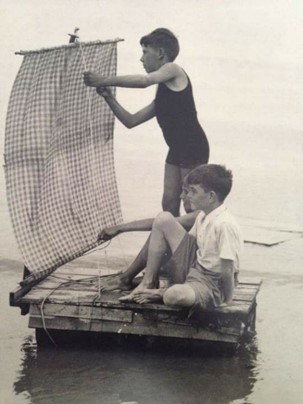The Jersey Shore – A great experience, the beach, the girls, the boats, the sailing, all good stuff for a growing boy
This Is How It Started
When I was about fourteen my folks bought a summer home at the Jersey shore. It was in a small beach community called Ocean Beach (in Lavalette, NJ) about halfway between Point Pleasant to the north and Seaside Heights to the south. Our house was on the Barnegat Bay on a street called Bay Shore Drive which led to a peninsula that jutted out into the bay. Ours was the third house from the end of the peninsula. It was in a great location right on the water overlooking the bay; a modest one-story beach house with a great view and boat dock.
Our neighbor was a stock broker with a rather elaborate house that included among other amenities a two-car garage as well as two baths. I was a pretty handy kid with tools and so my folks allowed me to build a vanity for the bathroom in our house. It turned out pretty well and one day my Mom showed it off to the neighbor. He asked me if I would build a similar vanity for his second bathroom and told me he would pay me for the job. Naturally, I agreed.
He bought the materials and I went to work. When it was finished, he paid me a few dollars for my work and then told me he had a small sailboat in his garage. He said I could have it, but it had a hole in the deck where someone stepped on it, but if I could fix it up it was mine.
My Dad bought me a ¼ inch 4 x 8 foot piece of marine plywood for the job and I went to work on it. I repaired the deck, gave it a new paint job and had my first sailboat; a sailfish, which is basically a surfboard with a mast, retractable fin keel and a tiller. I had no idea how to sail it and neither did my Dad since he was a power boat guy. Nevertheless, I launched it in Barnegat Bay, raised the sail and fooled around until I finally got the hang of it. I must have tipped it over a thousand times during my learning process but when you’re fourteen and a good swimmer that was just all part of the fun.
The Sailfish
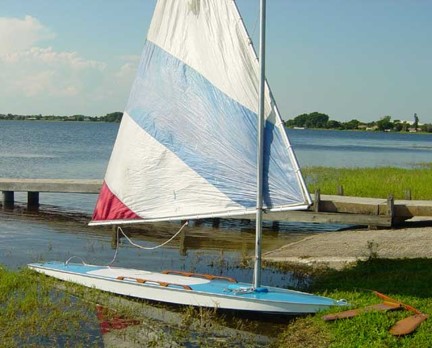
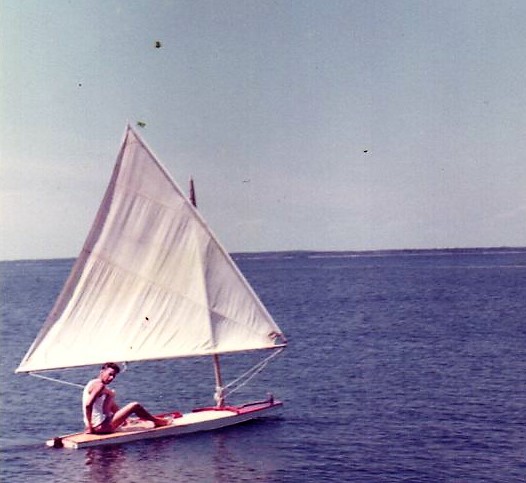
I recall my first experience tacking. I had no idea what tacking was but one afternoon out in the bay quite far to the north of home a stiff wind arose out of the south. I took off heading northbound with the wind at my back and was having a great time but wound up a considerable distance from home. I finally decided I better get back, so I came about into the wind and discovered that I was still heading northbound and my sail was flapping (luffing) in the breeze. The sailing term is “in irons”.
I didn’t realize then that the boat would not sail directly into the wind. I fooled around for a while until I discovered if I pointed the bow at an angle to the wind the boat would make forward progress but not exactly where I wanted to go. A little more experimentation and I was going forward at a different angle but again not on my desired course. OK, it dawned on me what I need to do is zig zag back home. So that’s what I did.
It took a couple of hours, but I finally made it back just before nightfall. I was back at the dock exhausted, had been more than a little panicked but now secure in my newly acquired knowledge of zig zagging. Years later I learned that zig zagging had a technical sailing term, “tacking”.
When I took my offshore sailing courses in Fort Lauderdale on a 38-foot sailboat, a Jeaneau, I realized the sailfish really was an excellent way to learn. Small boats, as sailors say, are “lively” which means everything happens fast and they are really easy to tip over. By comparison, on large sailboats everything happens in slow motion, but the basic principles are the same. If you can sail a small one, you can sail a big one.
I enjoyed that sailfish so much and spent so many hours sailing it that when I turned sixteen my Dad bought me a brand new “Snark” for my birthday.
The Snark
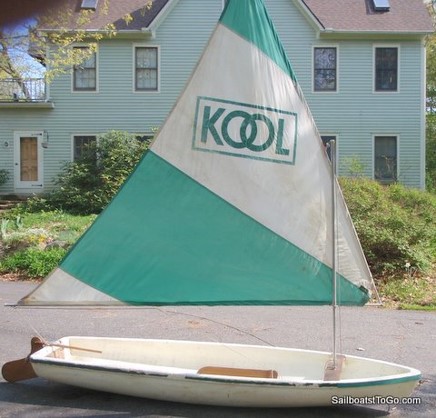
The Snark was a little bigger than the sailfish and had an actual cockpit with a seat at the tiller. I refined my sailing skills in the Snark and became adept at keeping her upright and skimming over the whitecaps. It was great fun and a great learning experience.
I also had a small secondhand runabout that my Dad bought for me. It was a fifteen-foot Lyman skiff with a twenty five horsepower Johnson outboard engine. It was a wooden boat with what is called a lap strake hull. That is the boards of the hull overlap rather than butt up to each other. It’s a more seaworthy design than a smooth hull.
The “Sea Tiger” – 15 ft. Lyman Outboard Skiff

The boat had a brass plaque on the dashboard with the name of the boat engraved on it, “Sea Tiger”. It was the mighty sea tiger; well more like the sea kitten but whatever. I never thought it was an appropriate name, but my Mom loved that name and always called the boat ‘Sea Tiger’. When I prepared to take it out, she would always ask, “Are you going out in the Sea Tiger?” I would always cringe when she said that and I’m sure that’s why she always said it. It became a private joke between us. It was a great little boat though and I spent many hours in the bay cruising and fishing and just messing around out on the water.
Most of the other kids my age living in the area had their own similar small outboard skiffs. We had a great time racing each other and exploring the tidal islands in the bay and generally learning by hands on experience about boats and tides and weather and all of the stuff you need to know to safely handle yourself on the water. These truly were the Halcyon Days of Summer.
“According to Greek mythology, Alcyone, the daughter of the god of the winds, became so distraught when she learned that her husband had been killed in a shipwreck that she threw herself into the sea and was changed into a kingfisher. As a result, ancient Greeks called such birds alkyon or halkyon. The legend also says that such birds built floating nests on the sea, where they so charmed the wind god that he created a period of unusual calm that lasted until the birds’ eggs hatched. This legend prompted people to use halcyon both as a noun naming a genus of kingfisher and as an adjective meaning either “of or relating to the kingfisher or its nesting period” or calm.”
Risky Behavior
Most of the time when I took ‘Sea Tiger’ out I would fool around in the bay with the other kids on boats and be back home by supper time. But there was an inlet not too far away, the Point Pleasant Inlet connecting the bay to the Atlantic Ocean and every once in a while…
At certain times, the inlet can be treacherous, especially when the wind runs against the tide. But from time to time I would take the ‘Sea Tiger’ out the inlet to the ocean and back just for adventure, just for the thrill of it. My folks never knew I did this. If they did, I am sure I would have been grounded for a long time.
Point Pleasant Inlet

But when you are a teenager you do stupid things and sometimes you are just plain lucky. I would purposely take the boat through the inlet during rough conditions just for the fun of it. I would generally take it out late in the afternoon and come back in with the fleet of large fishing boats returning to port to “ride and surf their wakes”. It was usually on an incoming tide. This is called a following sea and often times I would look behind me and there was a five or six foot wall of water directly behind the transom of my boat. The wave would not break until it hit shallow water and so you could ride the wave, so to speak, as long as you kept up your speed. It was a great thrill but dangerous as hell! There is nothing like impending disaster to focus the mind and somehow, I was lucky enough to stay focused and survive without any mishaps.
Recently in Florida there was a story that got a lot of attention on the local news about two teenage boys both fourteen years old, ostensibly experienced boaters and fishermen, who took their small 19 foot open cockpit outboard boat out of Jupiter, Florida and were lost at sea. Months later the damaged boat was found washed ashore in Bermuda nearly 700 miles away with life vests and one of the boy’s iPhone was aboard but no sign of the boys. It was stormy the day they went missing and they probably were overtaken by a sudden gale and heavy seas, the boat capsized, and they were not able to grab a hold and were lost at sea.
This story had a profound effect on me because of my own experience when I was that age. Like many of us, I thought I was “bulletproof” and could get away with risky behavior. And somehow by sheer luck I did. But when I heard about this incident, I couldn’t help but think, “There but for the grace of God go I.” Just thinking about this tragedy made me “weak in the knees”.
My Dad’s Boat
Shortly after we moved into the house in Ocean Beach my Dad bought an 18-foot Chris Craft mahogany speedboat with a trailer. The boat was a Chris Craft Riviera named “Playboy” with a 327 cu. in., 300 HP Chevrolet inboard engine. On flat water the boat could do 60 mph.
18 Ft. Chris Craft Riviera
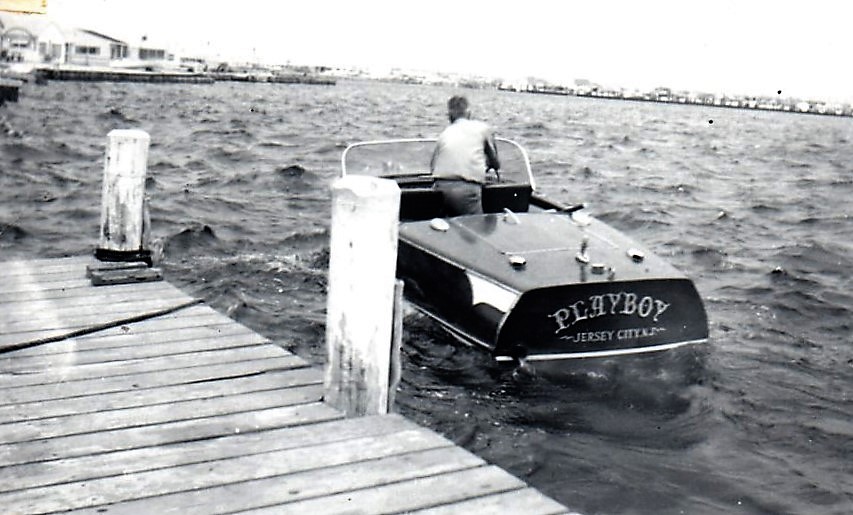
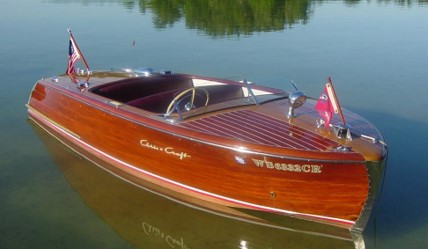
The Ocean Beach community had a small marina where he kept the boat. “Playboy” was the prettiest boat in the marina especially just after we worked on it all winter and re-varnished and re-caulked the hull and the deck. That was an annual project and a lot of work every year. These boats were designed for use on freshwater lakes, not for salt water. Every season we would take the boat back north, strip it down to “bare wood” and refinish the whole thing.
There was only one other boat in the marina that was more outrageous than “Playboy”. That was the Chris Craft Cobra owned by a guy from our hometown, Union, NJ, Pete Szpaichler. His nickname was “Spike” and he owned an auto body shop in town not far from the high school. He was a few years older than me and I didn’t know him very well, but I knew him by reputation.
Those were the times when all of the high school boys were into hot rods, most of which were more or less “junk” and needed a lot of work. Spike had a hell of a racket going with his auto body shop. He would let the kids work on their own cars in his shop and they would pay him to do so. Today with liability legislation, insurance and so forth this would be impossible. But in those days with the lax regulations he pulled it off.
At any given time, there would be seven or eight “hotrods” in his shop in various states of disrepair and the teenage owners and their buddies would be there every day after school working their butts off and paying Spike for the privilege. What a racket! I would see these guys in school, and they would brag, “Hey man, Spike lets me work in his shop,” like it was a status symbol. Idiots, they didn’t get it.
So, Spike had the 18 ft. Chris Craft Cobra with the custom metal flake gold paint job on the fiberglass cowling. He pulled it on a trailer with authentic wire wheels which matched the wire wheels on the 1955 pink Cadillac convertible he used to haul the boat.
18 Ft. Chris Craft Cobra
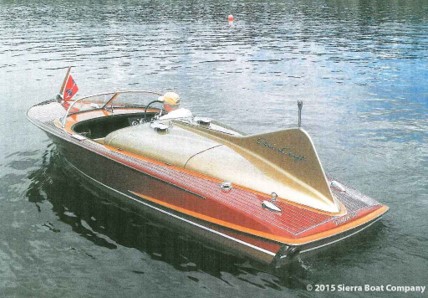
1955 pink Cadillac Convertible
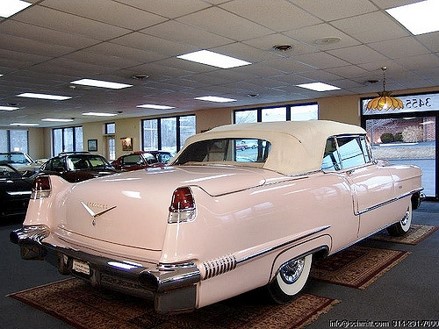
It was a sight to behold! Spike was quite the marketing genius in his time. He had a lineup of teenage ‘would be’ drag strip jockeys paying him to work in his shop on their cars. Wow, what a scam.
Where is Spike today? I don’t know, but I bet he is either in jail or he’s living on his multi-million-dollar mega yacht in Georgetown, Bahamas laughing his ass off.
My Dad’s Second Boat
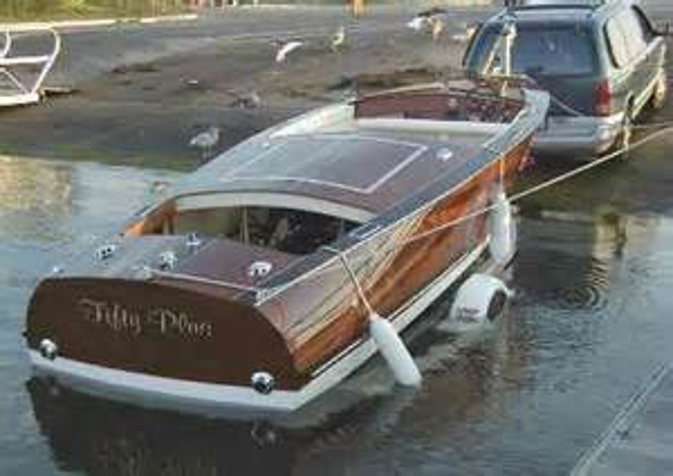
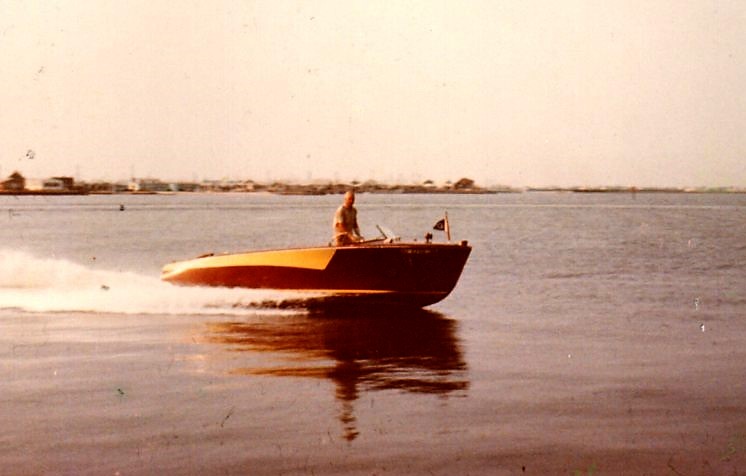
The name of this one was “SUNDANCER”. It was a 26-foot Shepherd mahogany speedboat built in Canada.
The Casino Arcade – Seaside Heights
When I was sixteen years old my first full time summer job was at the Seaside Heights boardwalk. I got a job in the amusements section at the Casino Arcade making change for customers for the pinball and skee-ball machines. The building also housed a fabulous old antique carousal. The carousal had a pipe organ in the center of the ride that was converted at some point to a mechanical device that played the organ continuously. It played one song all day and all night; Down Yonder. I would hear that tune every day all summer for sixteen hours a day. To this day sixty years later I know every note of down yonder by heart.
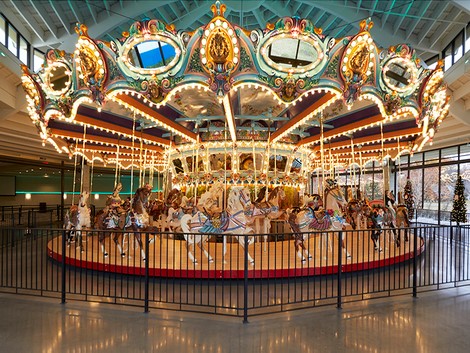
There was a dance hall on the second floor of the building that was open from six till midnight every night. I never went into the Casino Dance Hall as the age requirement was twenty-one. But every night I was entertained by the impromptu show going on just outside the dance hall.
The Harmonizers, Eh, doom bopa, DOOM BOPA, doom bopa, doo …
Every night about seven-o-clock, four or five amateur harmonizers, would congregate under the overhang at the Casino Arcade in Seaside Heights decked out in their Italian Knit shirts, three quarter length black leather jackets and PINZANO Milano black Fedora straw hats for an a capella jam session. They would start tapping their feet in unison and begin with “Eh, doom bopa, DOOM BOPA, doom bopa, doo …” Then the lead singer would break in in a soprano falsetto joined by the tenors and baritone while the bass continued to maintain the tempo “Eh, doom bopa, DOOM BOPA, doom bopa, doo …” These guys were great and never failed to draw an appreciative crowd. Different groups would show up at random and compete for the crowd’s approval every night of the week. The jam sessions would continue for several hours until late in the evening. These were the original Doo Wop A Capella groups of the 1950’s. Oh and by the way “Eh, doom bopa, DOOM BOPA, doom bopa, doo …” is the lead in to Why Do Fools Fall in Love by Frankie Lyman and the Teenagers circa 1956. How the hell do I remember that? That was more than sixty years ago. Amazing the trivia that’s stuck in your mind.
So long, good luck and have a nice day…
